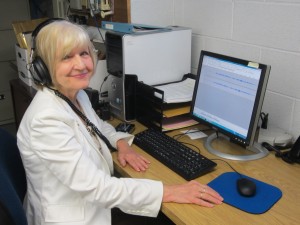Behind the Scenes – Oral History Digitizing
by Eileen Telegdy, Oberlin Heritage Center volunteer
I am Eileen Telegdy and in October of 2014 I retired, sold my home and moved to a condo in Oberlin. I responded to an ad Liz Schultz, the Museum Education and Tour Coordinator of the Oberlin Heritage Center, placed in the local paper in January of 2015 seeking volunteers to join the Oberlin Oral History Committee. I joined and volunteered to help digitize the cassette tapes from the Series II phase of the project (2000 to the present).
Digitizing the tapes is done in the basement of the Monroe House, which is teeming with activity by employees, interns, students and volunteers. The space is well utilized and surprisingly quiet, interrupted only by phone and doorbell rings and soft spoken conversations. Everyone is friendly, welcoming and helpful. Once an interview is completed it is painstakingly transcribed, saved to files on the computer and also printed and placed in a binder. A preface is also written, cassette labeled and cataloged in inventory. The quality of the tapes varies.
To digitize, the cassette tape is played on a converter connected to the computer with a USB cord. As the converter plays the tape, a free program called Audacity records it and then converts it into a WAV (sound) file. The results in a more efficient method of storage and improved preservation and availability. I found listening to the interviews captivating and compelling, so much so that I wanted to be in the basement of the Monroe House with earphones on four mornings a week for a couple of months. I listened to the interviews as they were recorded and simultaneously read the transcripts to check for any discrepancies. The chronicling from childhood to retirement years of multiple generations of residents who experienced all the conflict and challenges that faced our nation during the last millennium to the present is illuminating and hearing their stories in their own voices adds an invaluable dimension.
Since most interviews are not focused on one specific subject, information on various issues is revealed in an anecdotal manner in numerous interviews of different individuals, providing insight and understanding of very diverse positions on a multitude of issues. For example, the interviews explain the obstacles encountered and the procedures required that eventually brought Splash Zone, the industrial park, fair housing, Kendal, and the FAA to Oberlin, plus the beginning of Head Start and averting what was the apparent imminent closure of the hospital in Oberlin. This is not a comprehensive list; only a representation of some of the subjects discussed. All benefited from the perseverance and diligent efforts of hard working motivated individuals who believed in the betterment of the city for all ages and races. I think hearing the voices increases understanding of the transcripts exponentially. The voices provide intent, emotion and inflection that are lacking in the written word. It is my sincere hope this method will keep the interviews available for many years. Presently, all the cassette tapes in inventory have been digitized. It was a pleasure and privilege to contribute to this project.
Tags: digitization, digitizing, History, interview, Oberlin, oral history








July 1st, 2015 at 10:40 pm
Thank you for explaining digitization. Sounds like you really enjoyed preserving history!